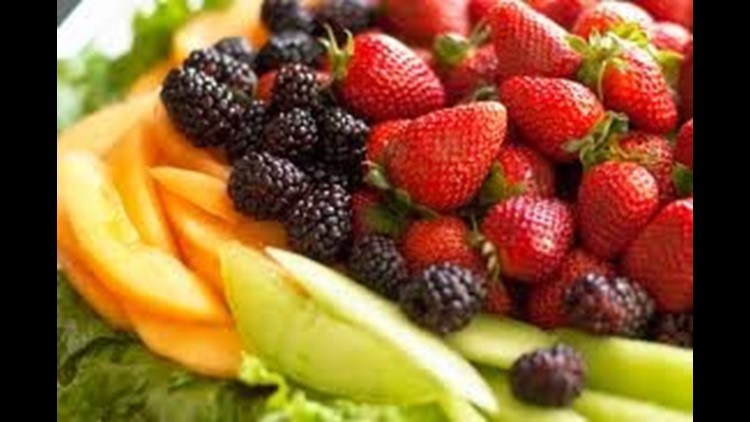It looks like a jewelry shop with its high-end exterior.
But a peek inside the sparkling glass display cases at any of Sembikiya‘s Tokyo outlets reveals expensive treasures of a surprising kind.
From heart-shaped watermelons to “Ruby Roman” grapes, which are the size of a ping pong ball, this retailer specializes in selling mouth-watering produce at eye-watering prices.
Expensive, carefully-cultivated fruit, however, is not unique to Sembikiya‘s stores.
Across Japan, such products regularly sell for tens of thousands of dollars at auction. In 2016, a pair of premium Hokkaido cantaloupe sold for a record $27,240 (3 million yen).
“Fruits are treated differently in Asian culture and in Japanese society especially,” Soyeon Shim, dean of the School of Human Ecology at the University of Wisconsin-Madison, tells CNN. “Fruit purchase and consumption are tied to social and cultural practices.
“It is not only an important part of their diet, but, perhaps more importantly, fruit is considered a luxury item and plays an important and elaborate ritual part in Japan’s extensive gift-giving practices.”
Cultivating status
Cultivating high-end produce usually involves meticulous, labor-intensive practices developed by Japanese farmers.
“It’s hard getting the shape of these strawberries right — they can sometimes turn out like globes,” says Okuda Nichio, of his highly-prized Bijin-hime (beautiful princess) strawberries, which he tries to grow “scoop-shaped”.
“It’s taken me 15 years to reach this level of perfection.”
Nichio’s strawberries each take 45 days to grow at his Okuda farm in Gifu prefecture, and although he won’t go into detail about how they are produced — “I can’t tell you exactly what the methods are because otherwise everyone else will catch on” — he believes it is time well spent.
His largest tennis-ball sized strawberries, of which he only produces around 500 a year, usually sell for more than 500,000 yen ($4,395) each.
Rarity is a tactic also employed by the producers of Japan’s “Ruby Roman” grapes, who offer just 2,400 bunches of the large red fruit each year.
The grapes were cultivated to fill a gap in the Japanese luxury fruit market, according to Ruby Roman spokesman Hirano Keisuke.
“These grapes look big and red — like a ruby. It’s been a painstaking process to achieve that red color,” he says.
First released in 2008, today individual bunches can sell for over 100,000 yen ($880) each — but that price can go much higher.
In southwest Japan last year, a supermarket paid 1.1 million yen ($9,700) for a first-harvest bunch of “Ruby Roman” at auction.
Holding just 30 grapes in total, that record-breaking bunch essentially sold for $320 per grape.
Gifts of perfection
So why are Japanese consumers willing to pay so much for their fruit?
Whereas in many Western cultures apples and oranges are prized for their nutritional value, the Japanese see fruit in almost spiritual terms, regularly offering it to the gods on their butsudan — or home altars — and Buddhist steps.
For this reason, high-end fruit has come to be viewed as an important symbol of respect.
“People purchase these expensive fruits to demonstrate how special their gifts are to the recipients, for special occasions or for someone socially important, like your boss,” says Shim, who has conducted extensive researched into Japan’s luxury fruit market.
Ken Gehrt, a professor of marketing at San Jose State University, in California, says the fruit is of particular importance during the gift-giving seasons of Ochugen and Oseibo, when presents are bestowed on people as a show of respect.
“Fine fruit is also given as part of the elaborately nuanced process of relationship cultivation in Japan,” adds Gehrt, who has conducted consumer research in Japan to help American fruit growers better understand the market.
The eye of the beholder
Great thought and presentation goes into even the smallest of fruit gifts.
As such single flawless strawberries are often sold in containers that resemble a jewelry box, while melons are individually wrapped and presented in ornate wooden boxes.
“It is said that the Japanese eat with their eyes. Certainly high-end fruit stands apart in terms of its beautiful appearance and the lovely way it is packaged and presented,” says Gehrt.
Rather than being a deterrent, for some consumers a high price tag adds prestige and signifies quality.
“In some ways, it’s like luxury chocolate, but giving it as a gift conveys status and regard for the other person,” explains Cecilia Smith Fujishima, a lecturer in comparative culture at Shirayuri University in Tokyo.
Although not all Japanese consumers buy expensive fruit to gift — many appreciate its rarefied taste.
But while many Japanese extol the exceptional flavors of these fruit, Smith Fujishima says it’s often too sweet for her Australian-raised tatste buds, and Western palettes in general.
“These fruits seem to be more delicious in a subtle way,” she says, hinting that the fine packaging and good marketing may influence people’s opinion on the taste.
“(People’s perceptions may also be affected by the fruit’s beautiful appearance and presentation as well as its more appealing texture.”



